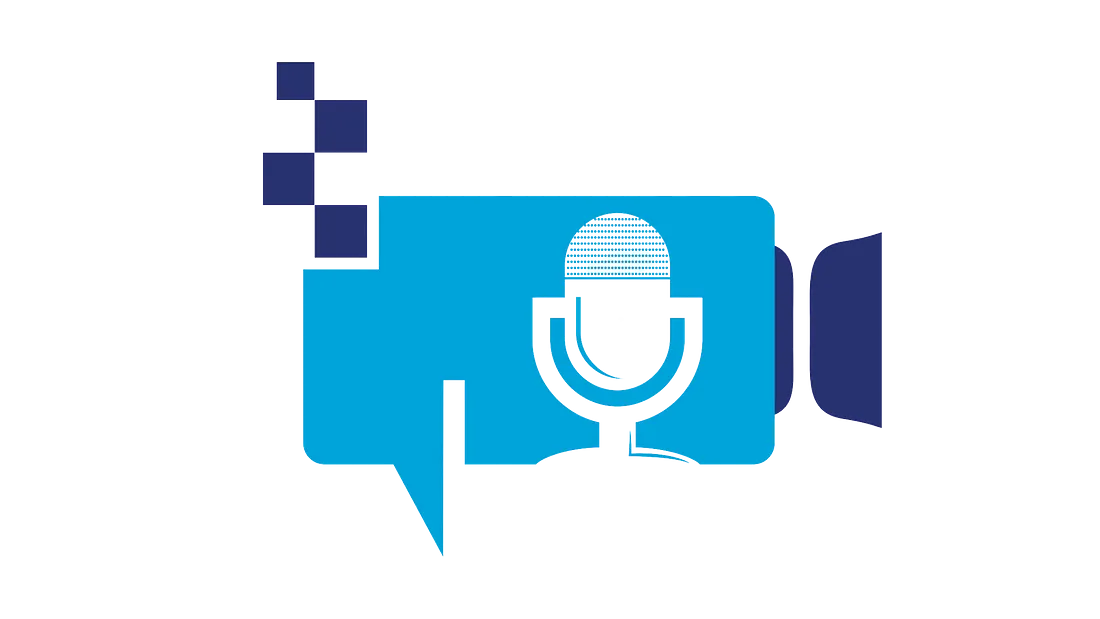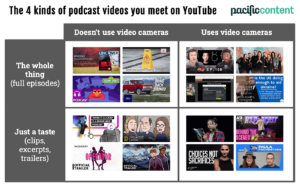The 4 kinds of video podcast examples you’ll meet on YouTube

Jeff Vidler from Signal Hill Insights calls YouTube “the elephant in the podcasting room.”
A lot of podcast listeners go to YouTube for podcasts. As a podcaster, you can choose to ignore that reality or embrace it. Wishing it away isn’t a workable option.
Meanwhile, Tom Webster cites data from Edison Research that suggests YouTube is the third most popular podcast platform in America. Tom’s been nudging podcast creators to think about YouTube for a while now:
The fact that most people listen to audio-only podcasts doesn’t mean that consumption of podcasts on video platforms doesn’t happen. It happens a lot.
What’s more, YouTube is reportedly incentivizing podcasters with funding:
The company is extending offers of $50,000 to individual shows and $200,000 and $300,000 to podcast networks, according to the people, who asked not to be identified because the matter is private. The money could help producers create filmed versions of their episodes or make other kinds of videos.
And soon, as slides obtained by Podnews suggest, YouTube may release new features that would make audio-first podcasts feel more at home on its platform:
YouTube is looking at ingesting podcast RSS feeds directly, the slides suggest, with a new podcasts homepage to be at youtube.com/podcasts (a URL that doesn’t work, yet). Podcasts appear to be promoted with familiar, square, artwork thumbnails.
But unless or until YouTube rolls out these new podcast-specific features, “podcasting on YouTube” can often feel like a frustrating hack, with many creators struggling to make audio-first content fit well onto a platform built for video.
Adding to the frustration, a “podcast on YouTube” can mean lots of different things, each requiring different levels of time, effort, and expense. A cheap-and-cheerful audiogram clip is very different from an hour-long live-to-tape multi-camera video shoot. Yet, too often, both approaches get lumped into one big bucket.

So, in an attempt to get specific about what we mean when we talk about podcasts on YouTube, I want to take a look at some of the most popular formats and approaches with some video podcast examples. But first…
A simple framework
Here are two of the most important questions when considering what types of videos to make for your podcast:
- Will we use video cameras?
- Will we post short clips, full episodes, or both?

Cameras vs. no cameras
I’ve written before about the value of human faces in marketing. Video footage is a great way to add an extra dimension of humanity to a medium that often depends on disembodied voices. That’s the upside.
Plus, podcast videos that use cameras are popular. According to data from the Canadian Podcast Listener, videos that include “audio with full video of the podcast hosts speaking” are the most widely-used type of podcast videos on YouTube.
The downside of cameras, of course, is that they almost always add time, effort, and cost to your podcast production workflow.
For certain types of shows, video footage can add tremendous value. Ask yourself: does my show’s subject matter, topic, or talent lend itself to video footage?
The full meal vs. just a taste
Podcast networks like Wondery, Gimlet, and CBC Podcasts seem to have found varying levels of success uploading full-length episodes to YouTube, often with an audiogram-style treatment. Ford Motor Company took this approach with Bring Back Bronco, making their series more accessible to people who don’t use Apple Podcasts, Spotify, or other audio-focused listening apps.
But full episodes aren’t the only valid use case. Tom Webster reminds us of the value of sample-sized excerpts or clips :
If your podcast is 60 or even 30 minutes, you need to offer that little slice of ham, for every episode, to make it easy to sample your show. Level zero of this for podcasters is to put more effort into show notes. Level one is to create a trailer. But the next level of the maze–the key to unlocking the secrets of the deli–is to always be making samples. Don’t leave it to your listeners to have to become audio editors. Isolate the best moments and share them.
Will your podcast’s YouTube strategy include promo clips? Full episodes? It’s probably not an either/or. Both add value but serve different goals.
Popular YouTube video podcast examples
Live-to-tape video recording of an interview or panel
You’ve seen this one. It uses cameras, but unlike a video recording made for broadcast television, few attempts are made to hide the artifice of the recording process. Microphones, stands, and other gear often appears on screen, as if to signal, “this is a podcast recording.”
Videos in this style are sometimes augmented with additional visual elements (like the still images and video clips in this episode of WVFRM), but the visuals are almost always supplementary because the episode needs to work well in its audio-only version, too:
This video style lends itself well to both full episodes and clips/excerpts. Savvy podcasters (like Marques Brownlee and Andrew Manganelli of Waveform) upload both: full episodes to the WVFRM Podcast channel, and clips to the Waveform Clips channel.
Other examples: WVFRM Podcast, School of Hustle from GoDaddy, Talk Python to Me, The Rich Roll Podcast, Steve-O’s Wild Ride! — Podcast,
A variant of this approach is what my colleague Russ More calls the “streamer model.” These are often recordings of a Twitch or YouTube livestream, which sometimes get edited and released in both an on-demand video version and an audio-only version. Video podcast example of this format include Critical Role and Dimension 20.
Audiograms
With no cameras required, the ever-popular audiogram is perhaps the lowest-cost and lowest-effort visual treatment for YouTube videos built on audio-first podcast recordings. Castos offers a helpful definition:
A podcast audiogram is an image that’s converted into a video and layered with other elements on top, such as a waveform and/or transcriptions. Essentially, it combines visual arts, audio tracks, soundwaves, and text to create a highly shareable marketing asset.
The simplest version of an audiogram requires only an audio file and static image. For example, here’s an episode of Goodnight, World! from Sesame Street and Headspace Studios:
A variation on this approach is the “audio + static image with Ken Burns effect panning and zooming” seen in this full episode of the Panic Podcast. Tools like FusionCast from Guilherme Rambo can make the creation of these videos straightforward. The web-based audiogram tool Headliner offers podcasters an “automatic audiograms” feature, with the option to auto-post to YouTube.
A slightly more complex version of this video podcast example adds an animated audio waveform, like this full episode of Bring Back Bronco from Ford Motor Company:
Podnews takes the same approach with its daily videos (static image + animated waveform), and editor James Cridland offers a detailed explanation of his video production workflow, which results in videos like this:
A slightly more sophisticated version of the audiogram includes audio + static image + waveform + looping video. The addition of a video loop adds a sense of movement. For example, check out the clouds in the sky in this full episode of Uncover: Satanic Panic from CBC Podcasts:
Animation
Animated videos add visual interest that’s often missing from podcast audiograms.
An animated approach can take many forms. For example, you could make a full-on cartoon, like the illustrated anecdotes from Office Ladies:
Or motion-graphics-heavy trailers like the visual trailer for When it Clicked:
But remember: just because animation doesn’t require video cameras, that doesn’t mean it’s quick, easy, or inexpensive to produce.
Some people listen to YouTube videos without watching
As a podcast creator, you can add a visual component to your show’s YouTube videos. But just because you include a visual component, that doesn’t necessarily mean your entire audience is consuming with their eyes.
Some listeners will likely disregard your video component entirely, choosing instead to listen to your video. Jeff Vidler of Signal Hill Insights explains:
We asked this question a couple of years ago and, on average, folks who access podcasts on YouTube said that 61% of the time they access podcasts on YouTube they are watching the video, leaving 39% of the time listening, not watching. As someone at Evolutions said, I’m listening to my podcast on YouTube while my phone is in my back pocket.
Looking ahead
I’m glad YouTube seems to be working on new features for podcasters, and I look forward to the day when audio feels less like a hack, and more like a first-class citizen on the platform. My sincere hope is that YouTube’s podcast features work well alongside other parts of the broader podcast ecosystem.
YouTube is an incredibly important platform for podcasters, but it’s not a panacea. As Jeff Vidler rightly points out, for all its potential in reaching new audiences, YouTube also represents monetization and measurement challenges for podcasters:
Downloads, not YouTube views, are the trading currency used to buy and sell podcasts. You get more revenue per listener from downloads than YouTube views. And you can’t add YouTube views to your podcast downloads. It’s adding apples to oranges and advertisers aren’t interested.
Remember
- Your podcast should probably have a presence on YouTube
- A “podcast on YouTube” can mean lots of different things
- Not all podcasts on YouTube have (or require) the same level of time, effort, or cost
- The most important questions when choosing a visual style for your show’s video treatment are: “cameras or no camera?” and “clips, full episodes, or both?”
Where do your podcast’s YouTube videos fit on this grid?

Sign up for the Pacific Content Newsletter: audio strategy, analysis, and insight in your inbox.
